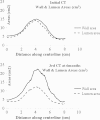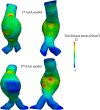Changes in geometric configuration and biomechanical parameters of a rapidly growing abdominal aortic aneurysm may provide insight in aneurysms natural history and rupture risk
- PMID: 24304476
- PMCID: PMC4235172
- DOI: 10.1186/1742-4682-10-67
Changes in geometric configuration and biomechanical parameters of a rapidly growing abdominal aortic aneurysm may provide insight in aneurysms natural history and rupture risk
Abstract
Background: Abdominal aortic aneurysms (AAA) are currently being treated based on the maximum diameter criterion which has often been proven insufficient to determine rupture risk in case of every AAA. We analyzed a rare case of an AAA which presented an extremely fast growth focusing on biomechanical determinants that may indicate a high risk profile. The examination of such a case is expected to motivate future research towards patient-specific rupture risk estimations.
Methods: An initially small AAA (maximum diameter: 4.5 cm) was followed-up and presented a growth of 1 cm in only 6-months of surveillance becoming suitable for surgical repair. Changes of morphometric characteristics regarding AAA, thrombus and lumen volumes, cross-sectional areas, thrombus maximum thickness and eccentricity, and maximum centerline curvature were recorded. Moreover biomechanical variables concerning Peak Wall Stress, AAA surface area exposed to high stress and redistribution of stress during follow-up were also assessed.
Results: Total aneurysm volume increased from 85 to 120 ml which regarded thrombus deposition since lumen volume remained stable. Thrombus deposition was eccentric regarding anterior AAA segment while its thickness increased from 0.3 cm to 1.6 cm. Moreover there was an anterior bulging over time as depicted by an increase in maximum centerline curvature from 0.4 cm-1 to 0.5 cm-1. Peak Wall Stress (PWS) exerted on aneurysm wall did not change significantly over time, slightly decreasing from 22 N/cm2 to 21 N/cm2. At the same time the area under high wall stress remained practically constant (9.9 cm2 at initial vs 9.7 cm2 at final examination) but there was a marked redistribution of wall stress against the posterior aneurysmal wall over time.
Conclusion: Aneurysm area under high stress and redistribution of stress against the posterior wall due to changes in geometric configuration and thrombus deposition over time may have implications to aneurysms natural history and rupture risk.
Figures





Similar articles
-
Correlation of Intraluminal Thrombus Deposition, Biomechanics, and Hemodynamics with Surface Growth and Rupture in Abdominal Aortic Aneurysm-Application in a Clinical Paradigm.Ann Vasc Surg. 2018 Jan;46:357-366. doi: 10.1016/j.avsg.2017.08.007. Epub 2017 Sep 6. Ann Vasc Surg. 2018. PMID: 28887252
-
Intraluminal thrombus is associated with early rupture of abdominal aortic aneurysm.J Vasc Surg. 2018 Apr;67(4):1051-1058.e1. doi: 10.1016/j.jvs.2017.08.069. Epub 2017 Nov 13. J Vasc Surg. 2018. PMID: 29141786
-
A novel strategy to translate the biomechanical rupture risk of abdominal aortic aneurysms to their equivalent diameter risk: method and retrospective validation.Eur J Vasc Endovasc Surg. 2014 Mar;47(3):288-95. doi: 10.1016/j.ejvs.2013.12.018. Epub 2014 Jan 20. Eur J Vasc Endovasc Surg. 2014. PMID: 24456739
-
Biomechanical Indices for Rupture Risk Estimation in Abdominal Aortic Aneurysms.J Endovasc Ther. 2017 Apr;24(2):254-261. doi: 10.1177/1526602816680088. Epub 2016 Nov 21. J Endovasc Ther. 2017. PMID: 27872318 Review.
-
Computational evaluation of aortic aneurysm rupture risk: what have we learned so far?J Endovasc Ther. 2011 Apr;18(2):214-25. doi: 10.1583/10-3244.1. J Endovasc Ther. 2011. PMID: 21521062 Review.
Cited by
-
The - Not So - Solid 5.5 cm Threshold for Abdominal Aortic Aneurysm Repair: Facts, Misinterpretations, and Future Directions.Front Surg. 2016 Jan 25;3:1. doi: 10.3389/fsurg.2016.00001. eCollection 2016. Front Surg. 2016. PMID: 26835458 Free PMC article. Review.
-
Advances in determining abdominal aortic aneurysm size and growth.World J Radiol. 2016 Feb 28;8(2):148-58. doi: 10.4329/wjr.v8.i2.148. World J Radiol. 2016. PMID: 26981224 Free PMC article. Review.
-
Vascular Deformation Mapping of Abdominal Aortic Aneurysm.Tomography. 2021 May 13;7(2):189-201. doi: 10.3390/tomography7020017. Tomography. 2021. PMID: 34067962 Free PMC article.
-
Time-dependent simulation of blood flow through an abdominal aorta with iliac arteries.Eur Biophys J. 2024 Nov;53(7-8):429-445. doi: 10.1007/s00249-024-01724-w. Epub 2024 Oct 18. Eur Biophys J. 2024. PMID: 39422728 Free PMC article.
-
Vertebral artery fusiform aneurysm geometry in predicting rupture risk.R Soc Open Sci. 2018 Oct 31;5(10):180780. doi: 10.1098/rsos.180780. eCollection 2018 Oct. R Soc Open Sci. 2018. PMID: 30473829 Free PMC article.
References
-
- Minino AM, Heron MP, Murphy SL, Kochanek KD. Deaths: final data for 2004. National Vital Stat Rep. 2007;55:1–119. - PubMed
-
- Hirsch AT, Haskal ZJ, Hertzer NR, Bakal CW, Creager MA, Halperin JL, Hiratzka LF, Murphy WR, Olin JW, Puschett JB, Rosenfield KA, Sacks D, Stanley JC, Taylor LM Jr, White CJ, White J, White RA, Antman EM, Smith SC Jr, Adams CD, Anderson JL, Faxon DP, Fuster V, Gibbons RJ, Hunt SA, Jacobs AK, Nishimura R, Ornato JP, Page RL, Riegel B. ACC/AHA 2005. Practice Guidelines for the management of patients with peripheral arterial disease (lower extremity, renal, mesenteric, and abdominal aortic): a collaborative report from the American Association for Vascular Surgery/Society for Vascular Surgery, Society for Cardiovascular Angiography and Interventions, Society for Vascular Medicine and Biology, Society of Interventional Radiology, and the ACC/AHA Task Force on Practice Guidelines (Writing Committee to Develop Guidelines for the Management of Patients With Peripheral Arterial Disease): endorsed by the American Association of Cardiovascular and Pulmonary Rehabilitation; National Heart, Lung, and Blood Institute; Society for Vascular Nursing; TransAtlantic Inter-Society Consensus; and Vascular Disease Foundation. Circulation. 2006;113:463–654. - PubMed
Publication types
MeSH terms
LinkOut - more resources
Full Text Sources
Other Literature Sources

